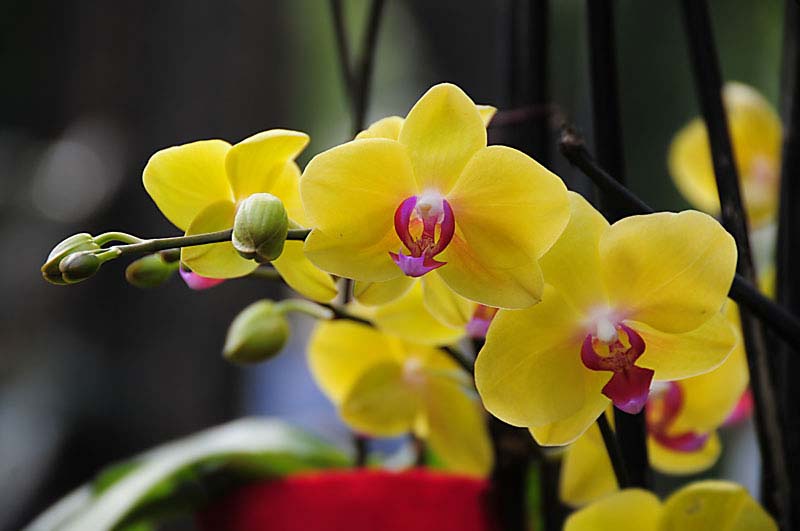If you can grow houseplants, you can grow orchids. Be not afraid.
Orchids have a reputation of being a difficult plant to grow, Kevin Kearns told a group of about 50 people at Skillin’s Greenhouse in Falmouth on a recent Saturday. Kearns is director of the Seedlings program at the Morrison Developmental Center in Scarborough and a past president of the Maine Orchid Society.
But if you choose the right orchid for the conditions in your house, you not only can get an orchid to survive, you can get it to rebloom.
First, you have to make a choice. There are about 30,000 species of orchids growing from inside the Arctic Circle to the Tropics, including 48 that grow in the wilds of Maine.
Kearns says he likes to grow orchids because they have unusual-looking flowers, and they come in all different shapes. Some blossoms are absolutely tiny; some are large. Some are the traditional lady slippers; some are striking because the petals and sepals are fused.
“I like day lilies,” he said, “but they all look like day lilies. The orchids are all so different.”
There are cool-condition orchids that prefer temperatures in the 40s and 50s, and warm-weather orchids that want temperatures around 70 to 75 degrees at night and higher during the day. Those could be grown in Maine houses, but before making that commitment, you have to know what kind of plant grower you are.
“You are either a gardener or a plant slave,” Kearns said. “A plant slave rearranges a vacation depending on what is in bloom.”
A plant slave also will figure out a way to get 75-degree temperatures and fairly moist conditions in a somewhat drafty Maine farmhouse in order to grow warm-weather orchids.
But if you are new to growing orchids and don’t want to become a slave to them, pick plants that want intermediate temperatures — in the 60s at night and around 70 days.
Kearns said some chain stores will ship warm-weather orchids from Florida to local stores, and they will not survive in most Maine houses.
Some orchids are terrestrial, growing in soil, including the Maine-native lady-slipper orchids. Others are lithophytes, growing on rocks, and those are complicated to care for.
Orchids commonly used as houseplants are epiphytes, which means they are supported by trees, telephone poles and other vertical structures and take their nutrients from the water and air.
Kearns said those orchids should be planted in a coarse bark medium — sold in plastic bags at gardening-supply stores — so the roots will get free-flowing air like they would have in the jungles. It doesn’t matter whether the plant pot is clay or plastic, although clay would be better if you have a tendency to water too often. And they should be transplanted when the bark starts to break down, or the roots will be smothered.
Orchids should be given a liquid fertilizer, and watering is best done as a mist in order to replicate falling rain. It also helps to keep the plants close together, making the air around the plants more humid.
Kearns also suggests keeping the orchids in an east- or southeast-facing window, although some orchids would prefer a southern window. And while it is probably OK to move them to a more visible location when they are in bloom, you don’t want to move them a lot.
“In nature, plants do not get up and move around,” he said. “Find a good location and leave them there.”
Like other houseplants, orchids can become infected by pests. But if you’re careful, you can keep them under control. First, colonies of pests such as aphids and whitefly grow exponentially. Which means if you see two and decide to put off removing them, you’ll soon have to remove 2,000. So the rule is, do it now.
And water is a very good pesticide.
“Just take the plants into the shower with you, and you’ll wash off a large percentage of the pests,” he said.
If the plants need more than washing, he recommends sun oil spray — which kills the pests by smothering them — or Neem oil, derived from the Neem tree.
Another important piece of information for orchids, Kearns said, is to hold onto the label. Even an orchid expert can’t tell exactly which orchid you have if it isn’t in bloom. If you’re ever looking for orchid advice, you’ll need to know which one you have.
If you want to grow native orchids in your garden, Kearns recommends the yellow lady slipper, sold by a number of garden centers. The pink lady slipper, which also comes in an albino form, requires specific conditions beneath evergreens and is very difficult to transplant. So leave them where they are unless construction is coming and they would be sure to die if left alone.
Skillin’s offered a series of classes on Saturdays through January and February. On Saturday at 10 a.m. in the Falmouth store and 2 p.m. in the Brunswick and Cumberland stores, the program will be “The Edible Landscape,” looking at how to grow berries and cherries, apples and pears and maybe more.
Skillin’s will also offer a four-part landscape design class at 5 p.m. Tuesdays March 8-29 at its Brunswick location. Check Skillins.com for any other classes.
Staff Writer Tom Atwell can be contacted at 791-6362 or at:
tatwell@pressherald.com
Send questions/comments to the editors.


